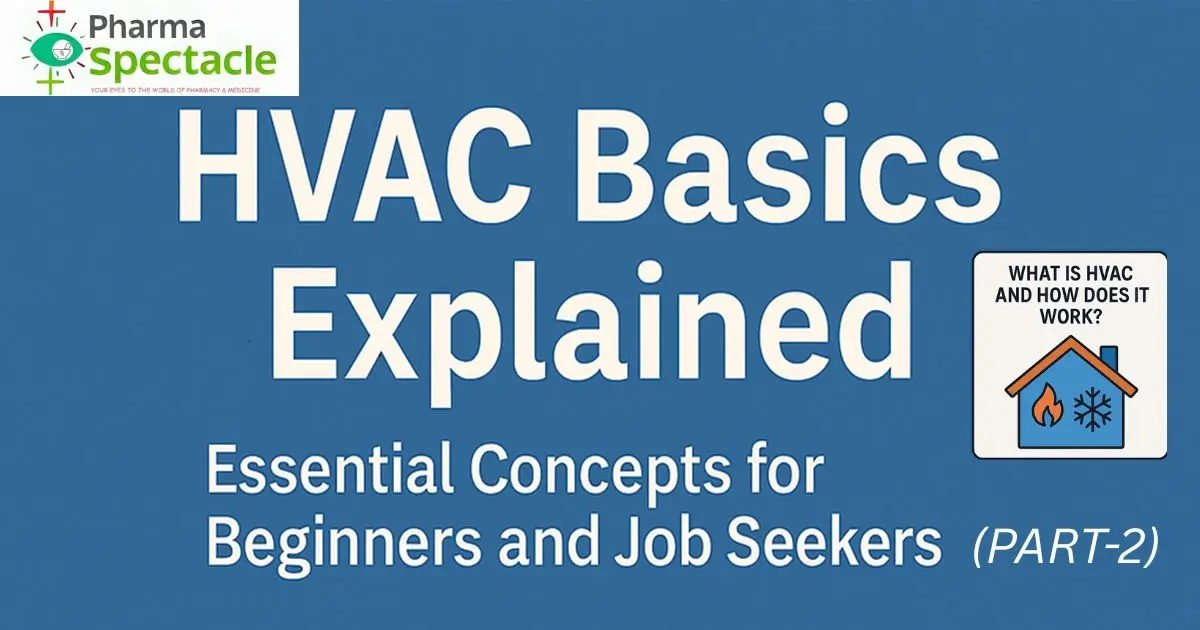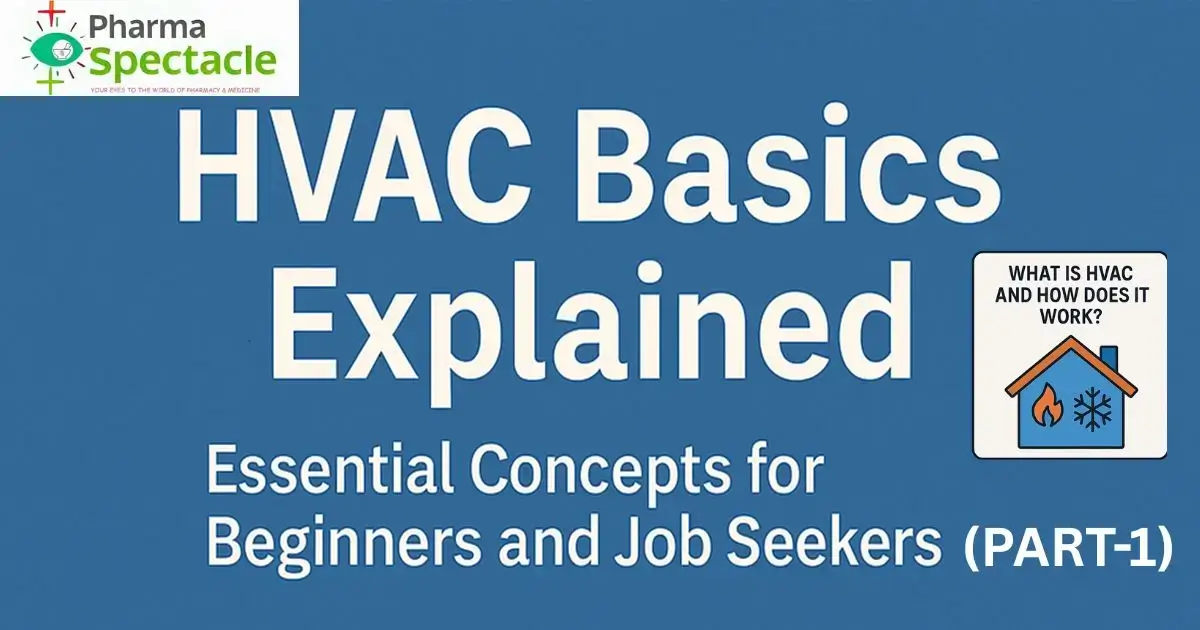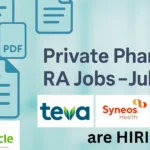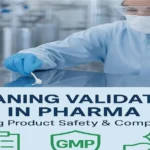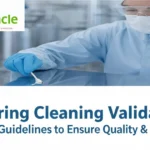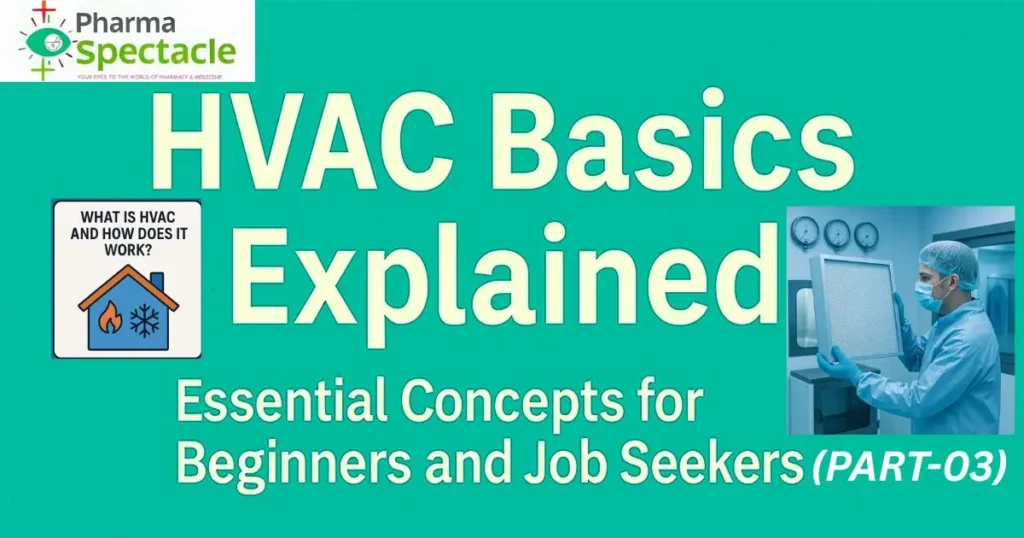
The pharmaceutical manufacturing environment imposes strict requirements on HVAC systems to ensure product quality, personnel safety, and compliance with regulations. Whether you’re working as an HVAC technician, engineer, or validation specialist, understanding the fundamentals of cleanroom HVAC is essential.
In this blog post, we’ll explore key interview questions and model answers focused on cleanroom HVAC systems, GMP requirements, and maintenance protocols in pharmaceutical plants.
Also Read:
HVAC Basics Explained – Essential Concepts for Beginners and Job Seekers
8 Types of HVAC Systems Explained: CAV, VAV, Split, Central & More (2025 Guide)
1. What is the role of HVAC in pharmaceutical cleanrooms?
HVAC systems in pharma cleanrooms are designed to:
- Regulate temperature and humidity within defined limits.
- Maintain cleanroom classification by controlling airborne particles.
- Control pressure differentials between adjacent spaces to avoid cross-contamination.
- Ensure unidirectional airflow to prevent contamination.
- Ensure proper air changes per hour (ACH) for microbial and particulate dilution
Maintaining these parameters is vital for GMP (Good Manufacturing Practice) compliance and to ensure product integrity and help prevent contamination of sensitive pharmaceutical products.
2. What are the classification levels of cleanrooms in pharma HVAC design?
Cleanrooms are classified based on maximum allowable particle concentration as per ISO 14644-1 and EU GMP guidelines. Classifications include:
- ISO 14644-1 (ISO Classes 1 to 9)
- EU GMP Grades A, B, C, D
Typical classifications in pharma:
- Grade A / ISO Class 5: Aseptic processing zones (e.g., sterile filling).
- Grade B / ISO Class 6–7: Background for aseptic areas.
- Grade C / ISO Class 7–8: Less critical processes like formulation.
- Grade D / ISO Class 8: Entry zones, preparation areas, Tablet formulation area.
Each grade has specific HVAC design requirements like particle concentration, airflow velocity, filter types, and pressure differentials.
3. What is an air change rate (ACH), and why is it important in cleanrooms?
ACH refers to the number of times the air within a room is replaced in an hour.
For example:
- ISO Class 5 / Grade A: >240–300 ACH
- ISO Class 7 / Grade C: 30–60 ACH
Higher ACH rates reduce particulate and microbial contamination, making them essential for sterile environments.
High ACH is essential to:
- Remove particulates and microorganisms.
- Maintain cleanroom classification.
- Minimize the risk of cross-contamination.
4. How is pressure differential maintained in pharma facilities?
Cleanroom HVAC systems are designed to maintain a pressure difference between two adjacent areas to prevent the ingress of contaminants. Differential pressure is typically:
- Between rooms: 10–15 Pascal
- Measured using Magnehelic gauges or transmitters, Digital pressure sensors.
Proper airflow direction (from clean to less clean) is maintained using airlocks.
5. What types of filters are used in cleanroom HVAC systems?
- Pre-filters (G4/F7): Remove large dust particles.
- Fine filters (F8/F9): Trap finer dust.
- HEPA filters (H13/H14): Remove ≥99.97% of particles ≥0.3 microns.
- ULPA filters (if needed): For higher efficiency
HEPA filters are installed at terminal points and require routine integrity testing using DOP/PAO methods.
6. What is unidirectional airflow (UDAF)?
UDAF (also called laminar airflow) is airflow in a single direction at a uniform velocity in a Vertical or horizontal direction, used to:
- Sweep particles away from critical areas.
- Maintain Grade A conditions in aseptic manufacturing.
Used in critical areas like:
- Sterile filling zones
- Sampling booths
- Biosafety cabinets
- Dispensing Areas.
UDAF ensures minimal turbulence, preventing particle accumulation and contamination.
7. What are the key HVAC validation parameters in pharma?
HVAC validation ensures system performance aligns with GMP. Key validation checks include:
- Airflow velocity and direction (visualized using smoke tests)
- Differential pressure mapping
- Temperature and humidity mapping
- HEPA Filter integrity test (DOP/PAO)
- Particle count monitoring (via laser particle counters)
- Recovery rate and air change rate tests
These are usually part of DQ/IQ/OQ/PQ documentation under GMP validation protocols.
8. What is HVAC preventive maintenance in pharmaceutical facilities?
In GMP environments, preventive maintenance is essential:
- Monthly: Check pressure gauges, calibrate sensors.
- Quarterly: Filter inspection and differential pressure logs.
- Half-yearly: HEPA integrity testing.
- Annually: Requalification, duct cleaning, and BMS review.
All activities must be documented as per GMP record-keeping norms and subject to audits.
9. What are the common causes of HVAC failure in cleanrooms?
- Blocked or damaged filters.
- Faulty dampers or actuators.
- Improper air balancing.
- Condensation and microbial growth in ducts.
- Sensor calibration drift or BMS error.
Such failures may cause non-compliance, product recalls, regulatory penalties, and batch rejection, so prompt corrective action is essential.
10. How does BMS help in HVAC control for pharma setups?
A Building Management System (BMS) integrates HVAC operations for:
- Real-time monitoring of parameters
- Alerting for deviation from setpoints
- Data logging for audits
- Energy efficiency via scheduling
A pharma BMS is often GAMP5 validated and 21 CFR Part 11 compliant, ensuring data integrity for audits.
Final Thoughts
In the pharmaceutical industry, HVAC systems are more than just infrastructure—they are key for compliance. From air filtration to airflow design, everything must adhere to strict standards. Understanding these cleanroom-specific HVAC concepts can help you succeed in your next pharma interview.
If you’re preparing for a job in a GMP-compliant facility, revise these questions, understand the logic behind each answer, and relate them to real-world scenarios. Your technical knowledge, combined with regulatory awareness, will set you apart.
Found this post helpful?
Share it with your friends & colleagues.
Follow us on WhatsApp & Telegram for job updates, interview tips, and study material:
Subscribe to PharmaSpectacle to stay ahead in the pharmaceutical world with valuable pharma knowledge and professional growth tips.

